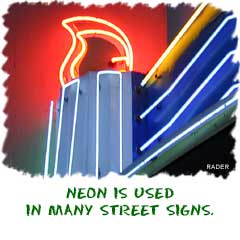THE NOBLE INERT GASES
 We love the inert gases. Some scientists used to call them the noble gases. These gases are another family of elements, and all of them are located in the far right column of the periodic table. For all of you budding chemists, the far right is also known as Group Zero (Group 0) or Group Eighteen (Group XVIII). This family has the happiest elements of all.
We love the inert gases. Some scientists used to call them the noble gases. These gases are another family of elements, and all of them are located in the far right column of the periodic table. For all of you budding chemists, the far right is also known as Group Zero (Group 0) or Group Eighteen (Group XVIII). This family has the happiest elements of all. WHY ARE THEY HAPPY?
Using the Bohr description of electron shells, happy atoms have full shells. All of the inert gases have full outer shells with eight electrons. Oh wait! That's not totally correct. At the top of the inert gases is little helium (He) with a shell that is full with two electrons. The fact that their outer shells are full means they are quite happy not reacting with other elements. In fact, they rarely combine with other elements. That nonreactivity is why they are called inert.WHO'S IN THE FAMILY?
 All of the elements in Group Zero are inert gases. The list includes Helium (He), Neon (Ne), Argon (Ar), Krypton (Kr), Xenon (Xe), and Radon (Rn). Don't think that because these elements don't like to react, we don't use them. You will find inert gases all over our world. Neon is used in advertising signs. Argon is used in light bulbs. Helium is used to cool things and in balloons. Xenon is used in headlights for new cars. When you move down the periodic table, as the atomic numbers increase, the elements become rarer. They are not just rare in nature but rare as useful elements, too.
All of the elements in Group Zero are inert gases. The list includes Helium (He), Neon (Ne), Argon (Ar), Krypton (Kr), Xenon (Xe), and Radon (Rn). Don't think that because these elements don't like to react, we don't use them. You will find inert gases all over our world. Neon is used in advertising signs. Argon is used in light bulbs. Helium is used to cool things and in balloons. Xenon is used in headlights for new cars. When you move down the periodic table, as the atomic numbers increase, the elements become rarer. They are not just rare in nature but rare as useful elements, too. BUT WAIT, THEY DO BOND! Some do. As of about 40 years ago, scientists have been able to make some compounds with inert gases. Some have been used in compounds to make explosives and other just form compounds in a lab. The thing to remember is that they were forced. When going about their natural lives, you will never (never say never because there may be an exception) find the inert gases bonded with other elements.
Source--http://www.chem4kids.com/files/elem_inertgas.html
Did you know: Atomic number of Krypton (Kr) is 36.
You might also like:
- What is the greenhouse effect
- Lecture by Prof. Yogendra Kumar Alagh on the subject of “Security and Governance in a liberalizing economy”(very long post but its concrete:))
- Science and TechnologY Current Affairs 2009
- Dealing with Terrorism: Alternatives for India( in context of the 26/11)
- The History of India's culture
Sunday, March 21, 2010
Human Body Muscle Diagram
Posted by swapnil on 10:58 AM



There are over 600 skeletal muscles in the human body attaching to a bone and connecting a joint to enable us to move our limbs.The neck muscles and massive triangular muscles of the back stabilize the head and shoulders and permit a range of complex movements. The most powerful muscles in the body and those that run along the spine. They maintain posture and provide the strength for lifting and pushing.
The face muscles control a wide range of movements and are especially complex around the mouth and eyes.



0 comments:
Post a Comment